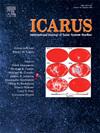地幔失踪问题之谜和光谱学的启示
IF 2.5
2区 物理与天体物理
Q2 ASTRONOMY & ASTROPHYSICS
引用次数: 0
摘要
本文章由计算机程序翻译,如有差异,请以英文原文为准。
The mystery of the missing mantle problem and insights from spectroscopy
Differentiation of planetesimals results in the segregation of materials, with the densest materials sinking, producing a metallic core, while the lighter fraction, rises, fabricating a crust. While there are multiple examples of planetary crusts (e.g., V-type asteroids) and metallic cores (e.g., M-type asteroids), there appears to be a scarcity of mantle-like materials in both the asteroid (e.g., A-type asteroids) and meteorite record. This lack of olivine-dominated material has been dubbed ‘The Missing Mantle Problem’. Here we measure the reflectance spectra of four olivine-rich meteorites expected to originate from the mantle of differing planetesimals. Following the Bus-DeMeo taxonomy, NWA 12264 and Chassigny can be classified as Sa-types, while NWA 8535 and NWA 15717 are classified as Q-types. This result implies that mantle-like materials are not restricted to A-type asteroids as previously expected. This study provides a significant step toward the resolution of the apparent shortage of olivine-rich material in the early Solar System.
求助全文
通过发布文献求助,成功后即可免费获取论文全文。
去求助
来源期刊

Icarus
地学天文-天文与天体物理
CiteScore
6.30
自引率
18.80%
发文量
356
审稿时长
2-4 weeks
期刊介绍:
Icarus is devoted to the publication of original contributions in the field of Solar System studies. Manuscripts reporting the results of new research - observational, experimental, or theoretical - concerning the astronomy, geology, meteorology, physics, chemistry, biology, and other scientific aspects of our Solar System or extrasolar systems are welcome. The journal generally does not publish papers devoted exclusively to the Sun, the Earth, celestial mechanics, meteoritics, or astrophysics. Icarus does not publish papers that provide "improved" versions of Bode''s law, or other numerical relations, without a sound physical basis. Icarus does not publish meeting announcements or general notices. Reviews, historical papers, and manuscripts describing spacecraft instrumentation may be considered, but only with prior approval of the editor. An entire issue of the journal is occasionally devoted to a single subject, usually arising from a conference on the same topic. The language of publication is English. American or British usage is accepted, but not a mixture of these.
 求助内容:
求助内容: 应助结果提醒方式:
应助结果提醒方式:


